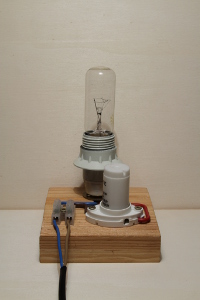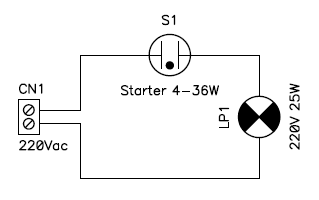
Picture of this lamp blinker (click to enlarge).
What is the simplest circuit you can think for building a blinker? How may components do you need? This circuit uses only two components, lamp included!
In my opinion, this is the simplest blinker, ever. You just need a filament light bulb and a starter; and can find them almost everywhere. Try visiting a friend that doesn't has the hobby of electronics and who's not a home-brewer at all; bet that you can build a blinker with the stuff you find in his place: with this circuit you'll win almost every time.

Picture of this lamp blinker (click to enlarge).
Use a fluorescent tube glow starter; electronic starters or fast starters don't work well (or don't work at all). Make sure the power rating of the starter roughly matches the power of the light bulb. Usually, a lamp of lower power blinks at a slower rate. Use a filament lamp, halogen or not, but compact fluorescent lamps won't work.
The circuit diagram is very simple, but I decided to draw it anyway. You just have the light bulb in series with the starter, nothing more.

Circuit diagram of the blinker.
As you can see in the following movie, the frequency of oscillation is not stable and a little random, but from such a simple circuit you shouldn't expect too much...

Watch the movie: starterflasher.mp4
(316,823 bytes, 10 s, H264, 480 × 272, 24 fps).
The circuit described here works on a 220/230 VAC mains; I have no idea if it works also on 120 VAC mains, using, of course, a 120 V lamp and a suitable starter (I believe starters are also different); I think it should, but I never tested it.
I also don't know how long the starter will last, since normally it's not designed for continuous operation, but it will last long enough to have some fun with this circuit.
Warning: as usual with mains voltage circuits, beware of electrical shocks and don't attempt to build this circuit if you don't know what you're doing. In other words, build it at your own risk.
| Home | Electronics | Page hits: 025142 | Created: 12.2013 | Last update: 12.2013 |